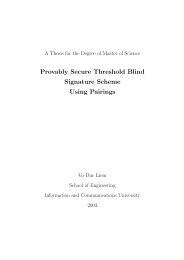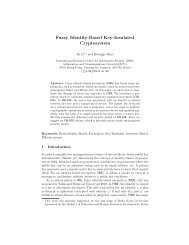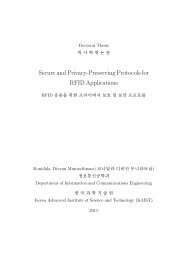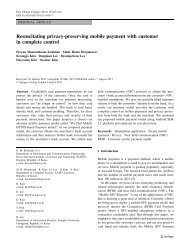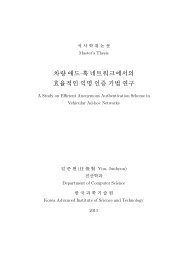RFID-enabled Extensible Authentication Framework and Its ...
RFID-enabled Extensible Authentication Framework and Its ...
RFID-enabled Extensible Authentication Framework and Its ...
Create successful ePaper yourself
Turn your PDF publications into a flip-book with our unique Google optimized e-Paper software.
[19], <strong>and</strong> hash-based ID variation (HIDV) scheme [20]. However, these<br />
schemes except HIDV are vulnerable to replay <strong>and</strong> tag spoofing attacks.<br />
RHL <strong>and</strong> HC are impractical for suppliers <strong>and</strong> distributors because of<br />
their scalability problem. HIDV scheme does not work with desynchro-<br />
nized DB caused by unreliable RF communication or attacks. To solve<br />
these problems, we will propose a hash-based authentication method for<br />
our proposed <strong>RFID</strong> authentication framework.<br />
(3) Block-Cipher-based <strong>Authentication</strong> Methods<br />
The first <strong>RFID</strong> authentication protocol using a block cipher was pro-<br />
posed by Feldhofer et al. [4, 6]. Their novel approach of an AES hard-<br />
ware implementation has achieved low power consumption <strong>and</strong> low die-<br />
size. Kaps et al. [8] also implemented AES encryption in CBC mode<br />
with the viable number of NAND gate equivalents. Feldhofer et al.’s<br />
recent work [5] suggested that AES-128 is more appropriate for <strong>RFID</strong><br />
systems than any other hash functions. Usually, a low-cost <strong>RFID</strong> tag<br />
means a passive <strong>RFID</strong> tag less than 5 cents with roughly 500-5,000 gates<br />
[14]. Besides AES, light-weight block ciphers such as mCrypton [11],<br />
HIGHT [12], <strong>and</strong> PRESENT [13] are developed for resource-constraint<br />
devices. These implementations with less than 3,000 gates show that<br />
block ciphers are affordable for low-cost <strong>RFID</strong> tags.<br />
Based on AES hardware implementation, following <strong>RFID</strong> authenti-<br />
cation protocols using AES are proposed. Feldhofer [3] <strong>and</strong> Dominukus<br />
et al. [2] proposed a challenge-response authentication protocol con-<br />
forming to ISO/IEC 18000-3 st<strong>and</strong>ard. Toiruul et al. [9] proposed a<br />
mutual authentication protocol with two shared r<strong>and</strong>om secrets. How-<br />
ever, these protocols have some drawbacks. Protocol 5 in [2] requires<br />
one AES decryption which is not implemented in practice. When us-<br />
ing different secret keys for different product classes, [2] have scalabil-<br />
ity problems to find a correct key. [9] requires three consecutive AES<br />
3



